Economics Assignment: Microeconomics Principles and Applications
VerifiedAdded on 2022/10/11
|10
|1048
|17
Homework Assignment
AI Summary
This economics assignment delves into several key microeconomic concepts. It begins by exploring the concept of opportunity cost through a personal decision-making example. The assignment then examines the benefits of trade and specialization. A significant portion is dedicated to analyzing production possibility frontiers (PPF) and how various events, such as droughts, can impact them. The document further investigates the effects of changes in supply and demand on market equilibrium, using the example of tourism in Thailand. It also discusses the impact of taxes on market participants, considering the elasticity of supply and demand. Finally, the assignment calculates and compares the price elasticity of demand for business travelers and vacationers, providing insights into their differing behaviors. The assignment uses figures and diagrams to illustrate economic concepts and provides references to relevant literature.
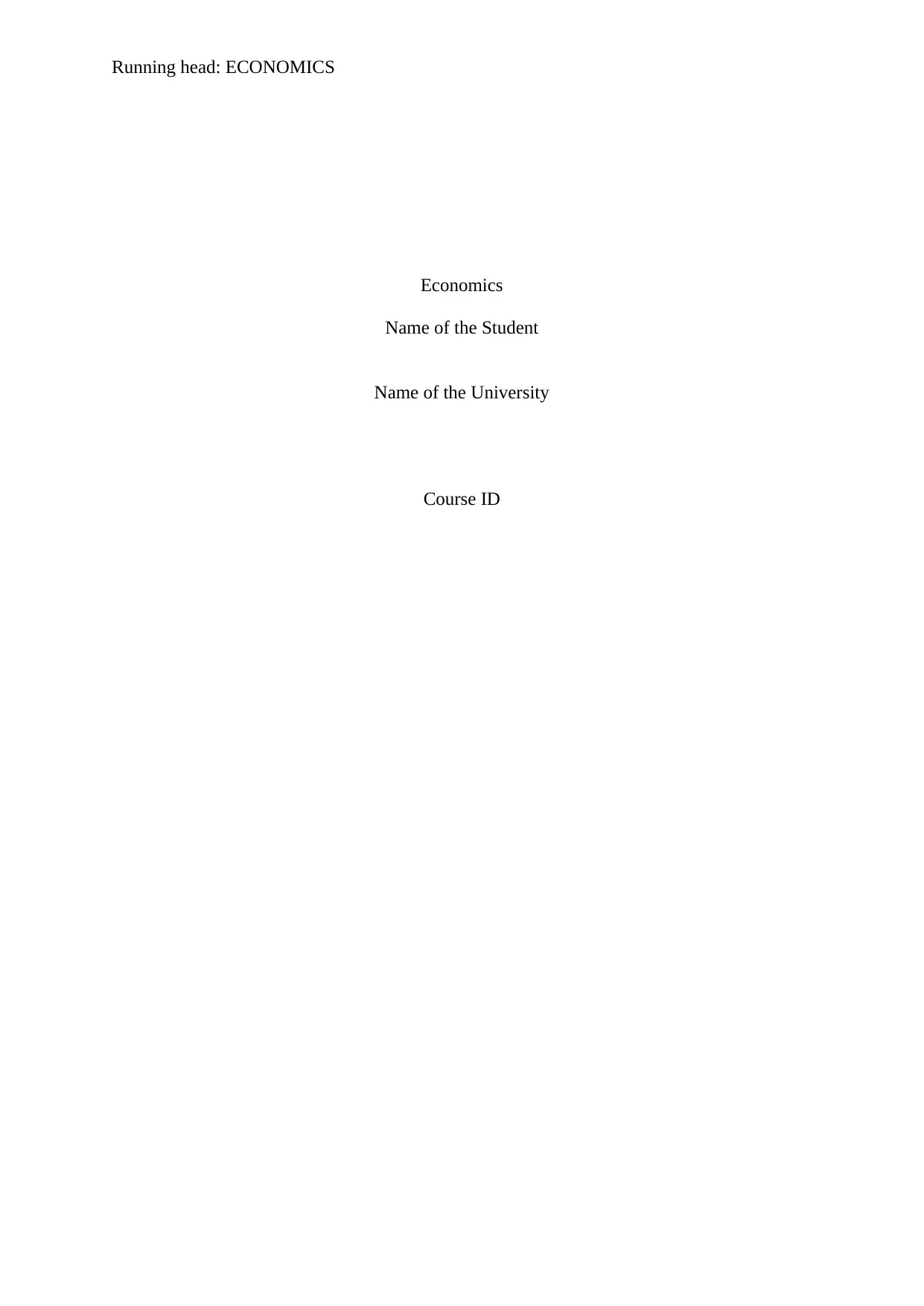
Running head: ECONOMICS
Economics
Name of the Student
Name of the University
Course ID
Economics
Name of the Student
Name of the University
Course ID
Paraphrase This Document
Need a fresh take? Get an instant paraphrase of this document with our AI Paraphraser
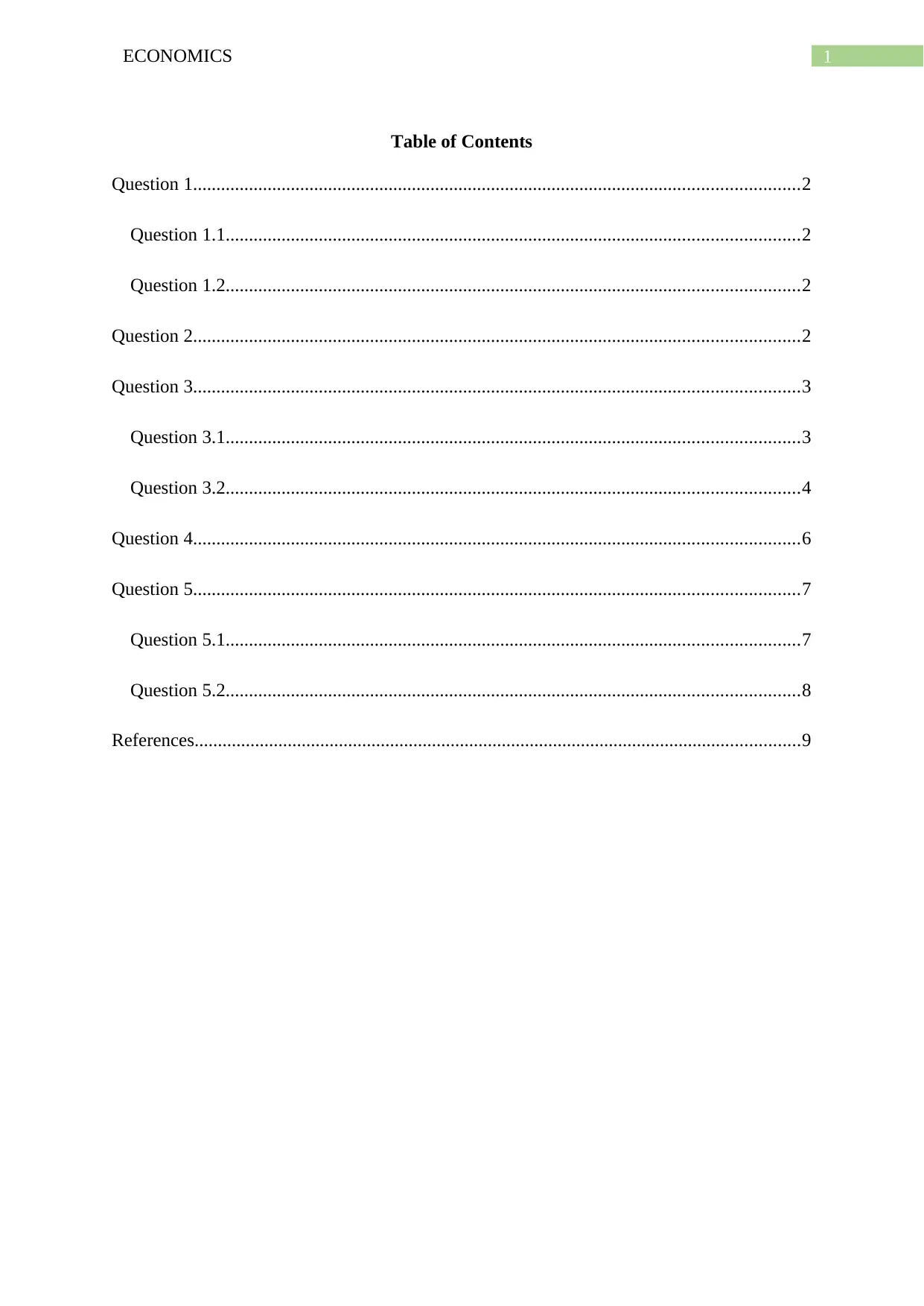
1ECONOMICS
Table of Contents
Question 1..................................................................................................................................2
Question 1.1...........................................................................................................................2
Question 1.2...........................................................................................................................2
Question 2..................................................................................................................................2
Question 3..................................................................................................................................3
Question 3.1...........................................................................................................................3
Question 3.2...........................................................................................................................4
Question 4..................................................................................................................................6
Question 5..................................................................................................................................7
Question 5.1...........................................................................................................................7
Question 5.2...........................................................................................................................8
References..................................................................................................................................9
Table of Contents
Question 1..................................................................................................................................2
Question 1.1...........................................................................................................................2
Question 1.2...........................................................................................................................2
Question 2..................................................................................................................................2
Question 3..................................................................................................................................3
Question 3.1...........................................................................................................................3
Question 3.2...........................................................................................................................4
Question 4..................................................................................................................................6
Question 5..................................................................................................................................7
Question 5.1...........................................................................................................................7
Question 5.2...........................................................................................................................8
References..................................................................................................................................9
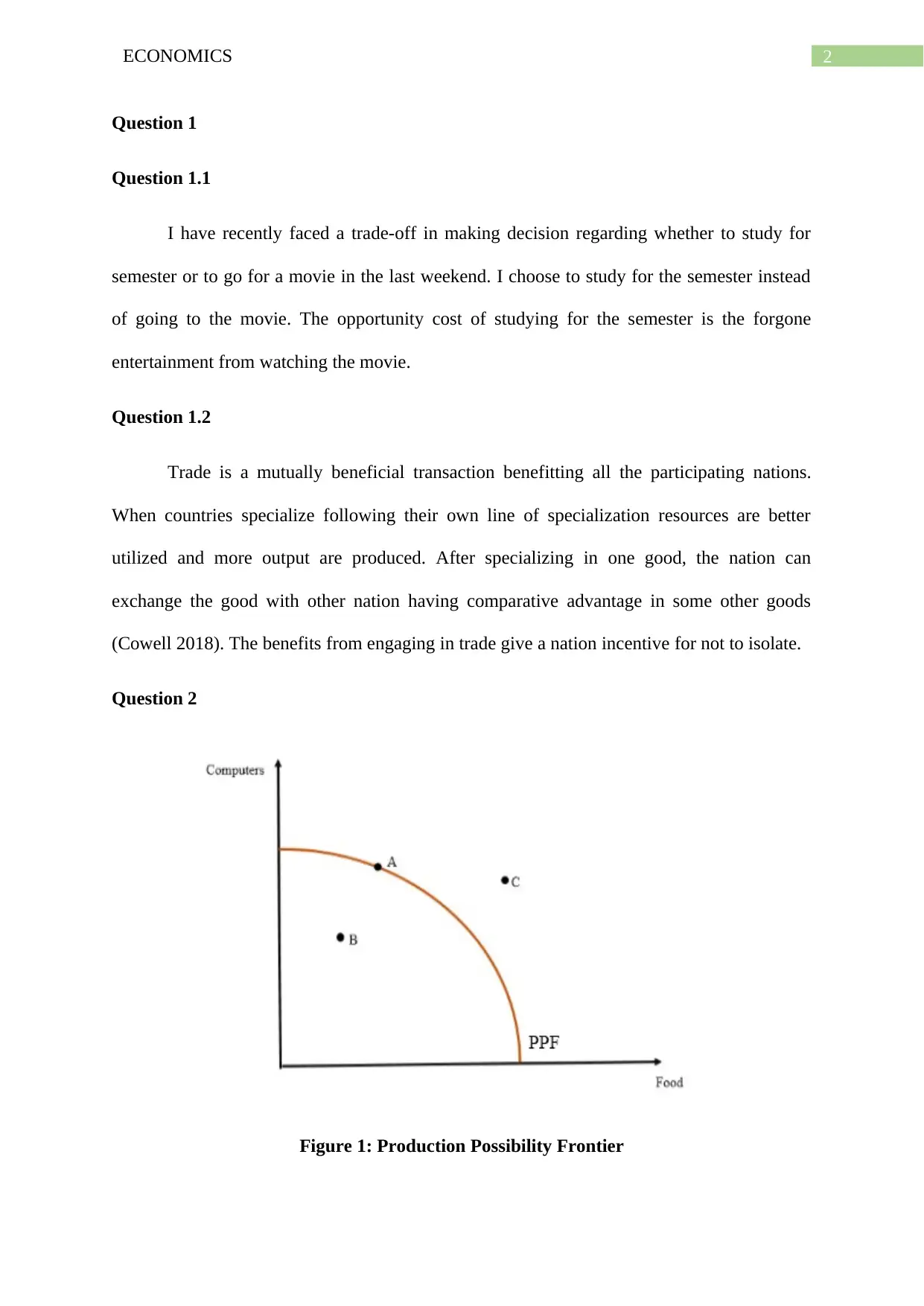
2ECONOMICS
Question 1
Question 1.1
I have recently faced a trade-off in making decision regarding whether to study for
semester or to go for a movie in the last weekend. I choose to study for the semester instead
of going to the movie. The opportunity cost of studying for the semester is the forgone
entertainment from watching the movie.
Question 1.2
Trade is a mutually beneficial transaction benefitting all the participating nations.
When countries specialize following their own line of specialization resources are better
utilized and more output are produced. After specializing in one good, the nation can
exchange the good with other nation having comparative advantage in some other goods
(Cowell 2018). The benefits from engaging in trade give a nation incentive for not to isolate.
Question 2
Figure 1: Production Possibility Frontier
Question 1
Question 1.1
I have recently faced a trade-off in making decision regarding whether to study for
semester or to go for a movie in the last weekend. I choose to study for the semester instead
of going to the movie. The opportunity cost of studying for the semester is the forgone
entertainment from watching the movie.
Question 1.2
Trade is a mutually beneficial transaction benefitting all the participating nations.
When countries specialize following their own line of specialization resources are better
utilized and more output are produced. After specializing in one good, the nation can
exchange the good with other nation having comparative advantage in some other goods
(Cowell 2018). The benefits from engaging in trade give a nation incentive for not to isolate.
Question 2
Figure 1: Production Possibility Frontier
⊘ This is a preview!⊘
Do you want full access?
Subscribe today to unlock all pages.

Trusted by 1+ million students worldwide
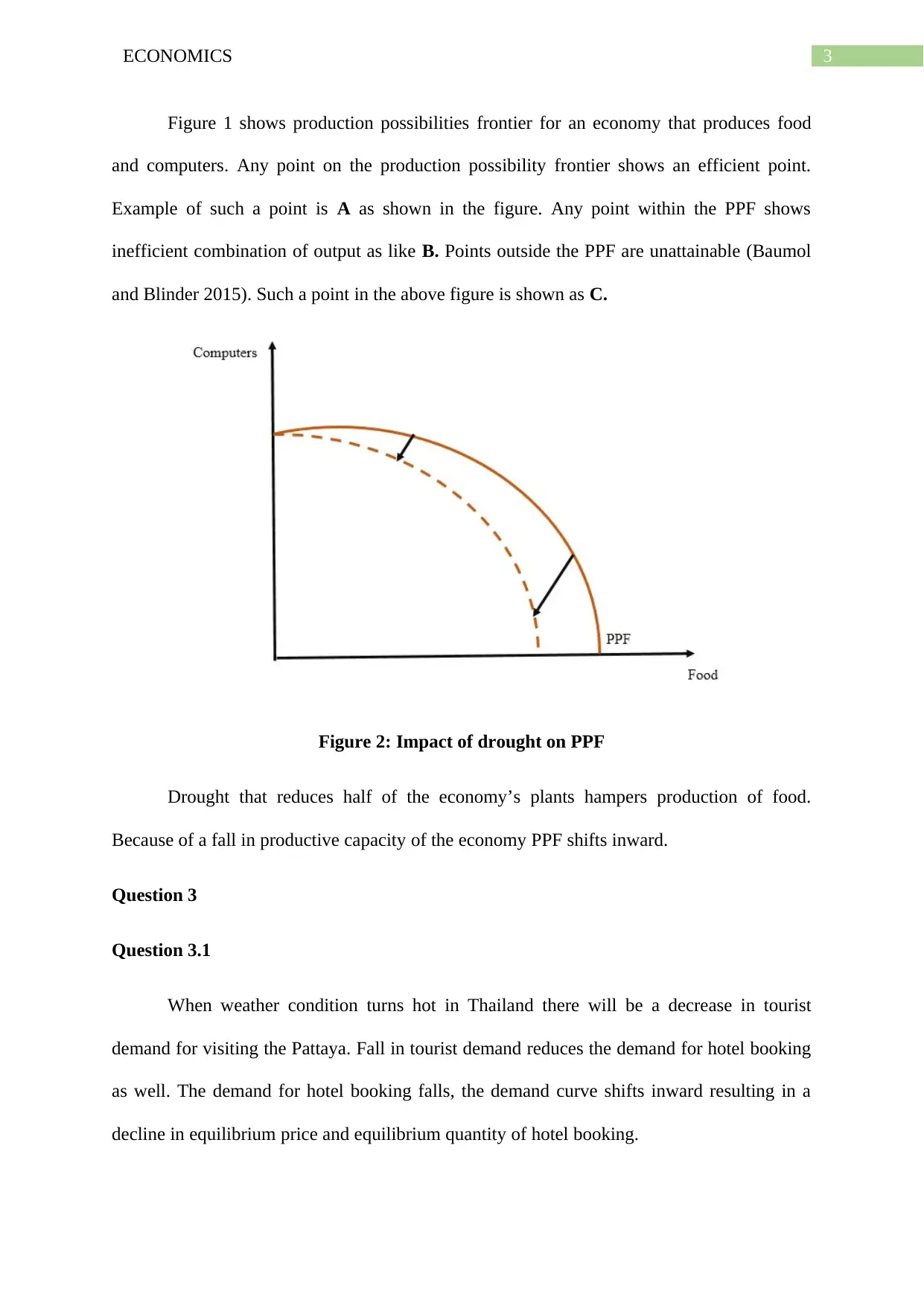
3ECONOMICS
Figure 1 shows production possibilities frontier for an economy that produces food
and computers. Any point on the production possibility frontier shows an efficient point.
Example of such a point is A as shown in the figure. Any point within the PPF shows
inefficient combination of output as like B. Points outside the PPF are unattainable (Baumol
and Blinder 2015). Such a point in the above figure is shown as C.
Figure 2: Impact of drought on PPF
Drought that reduces half of the economy’s plants hampers production of food.
Because of a fall in productive capacity of the economy PPF shifts inward.
Question 3
Question 3.1
When weather condition turns hot in Thailand there will be a decrease in tourist
demand for visiting the Pattaya. Fall in tourist demand reduces the demand for hotel booking
as well. The demand for hotel booking falls, the demand curve shifts inward resulting in a
decline in equilibrium price and equilibrium quantity of hotel booking.
Figure 1 shows production possibilities frontier for an economy that produces food
and computers. Any point on the production possibility frontier shows an efficient point.
Example of such a point is A as shown in the figure. Any point within the PPF shows
inefficient combination of output as like B. Points outside the PPF are unattainable (Baumol
and Blinder 2015). Such a point in the above figure is shown as C.
Figure 2: Impact of drought on PPF
Drought that reduces half of the economy’s plants hampers production of food.
Because of a fall in productive capacity of the economy PPF shifts inward.
Question 3
Question 3.1
When weather condition turns hot in Thailand there will be a decrease in tourist
demand for visiting the Pattaya. Fall in tourist demand reduces the demand for hotel booking
as well. The demand for hotel booking falls, the demand curve shifts inward resulting in a
decline in equilibrium price and equilibrium quantity of hotel booking.
Paraphrase This Document
Need a fresh take? Get an instant paraphrase of this document with our AI Paraphraser
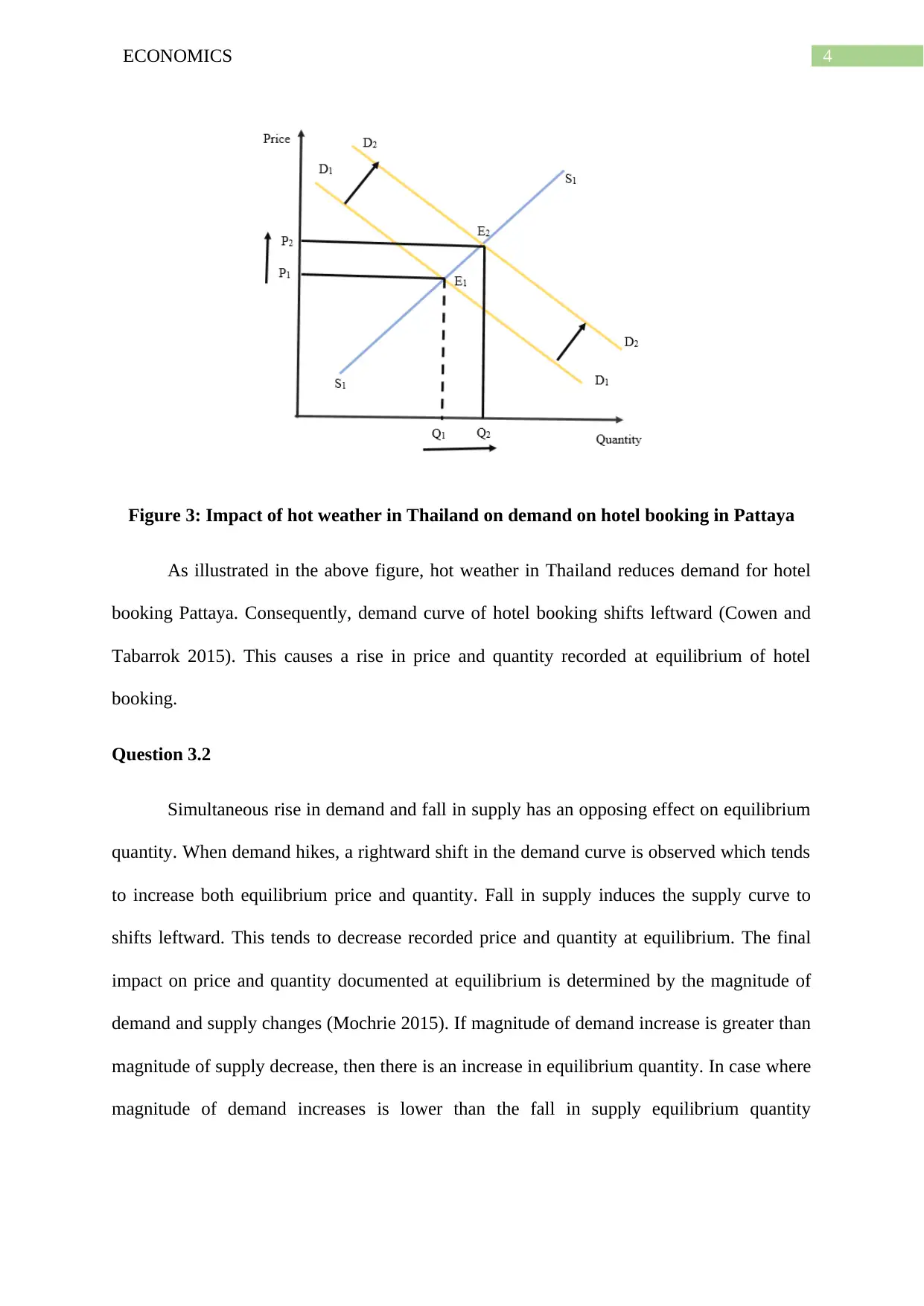
4ECONOMICS
Figure 3: Impact of hot weather in Thailand on demand on hotel booking in Pattaya
As illustrated in the above figure, hot weather in Thailand reduces demand for hotel
booking Pattaya. Consequently, demand curve of hotel booking shifts leftward (Cowen and
Tabarrok 2015). This causes a rise in price and quantity recorded at equilibrium of hotel
booking.
Question 3.2
Simultaneous rise in demand and fall in supply has an opposing effect on equilibrium
quantity. When demand hikes, a rightward shift in the demand curve is observed which tends
to increase both equilibrium price and quantity. Fall in supply induces the supply curve to
shifts leftward. This tends to decrease recorded price and quantity at equilibrium. The final
impact on price and quantity documented at equilibrium is determined by the magnitude of
demand and supply changes (Mochrie 2015). If magnitude of demand increase is greater than
magnitude of supply decrease, then there is an increase in equilibrium quantity. In case where
magnitude of demand increases is lower than the fall in supply equilibrium quantity
Figure 3: Impact of hot weather in Thailand on demand on hotel booking in Pattaya
As illustrated in the above figure, hot weather in Thailand reduces demand for hotel
booking Pattaya. Consequently, demand curve of hotel booking shifts leftward (Cowen and
Tabarrok 2015). This causes a rise in price and quantity recorded at equilibrium of hotel
booking.
Question 3.2
Simultaneous rise in demand and fall in supply has an opposing effect on equilibrium
quantity. When demand hikes, a rightward shift in the demand curve is observed which tends
to increase both equilibrium price and quantity. Fall in supply induces the supply curve to
shifts leftward. This tends to decrease recorded price and quantity at equilibrium. The final
impact on price and quantity documented at equilibrium is determined by the magnitude of
demand and supply changes (Mochrie 2015). If magnitude of demand increase is greater than
magnitude of supply decrease, then there is an increase in equilibrium quantity. In case where
magnitude of demand increases is lower than the fall in supply equilibrium quantity
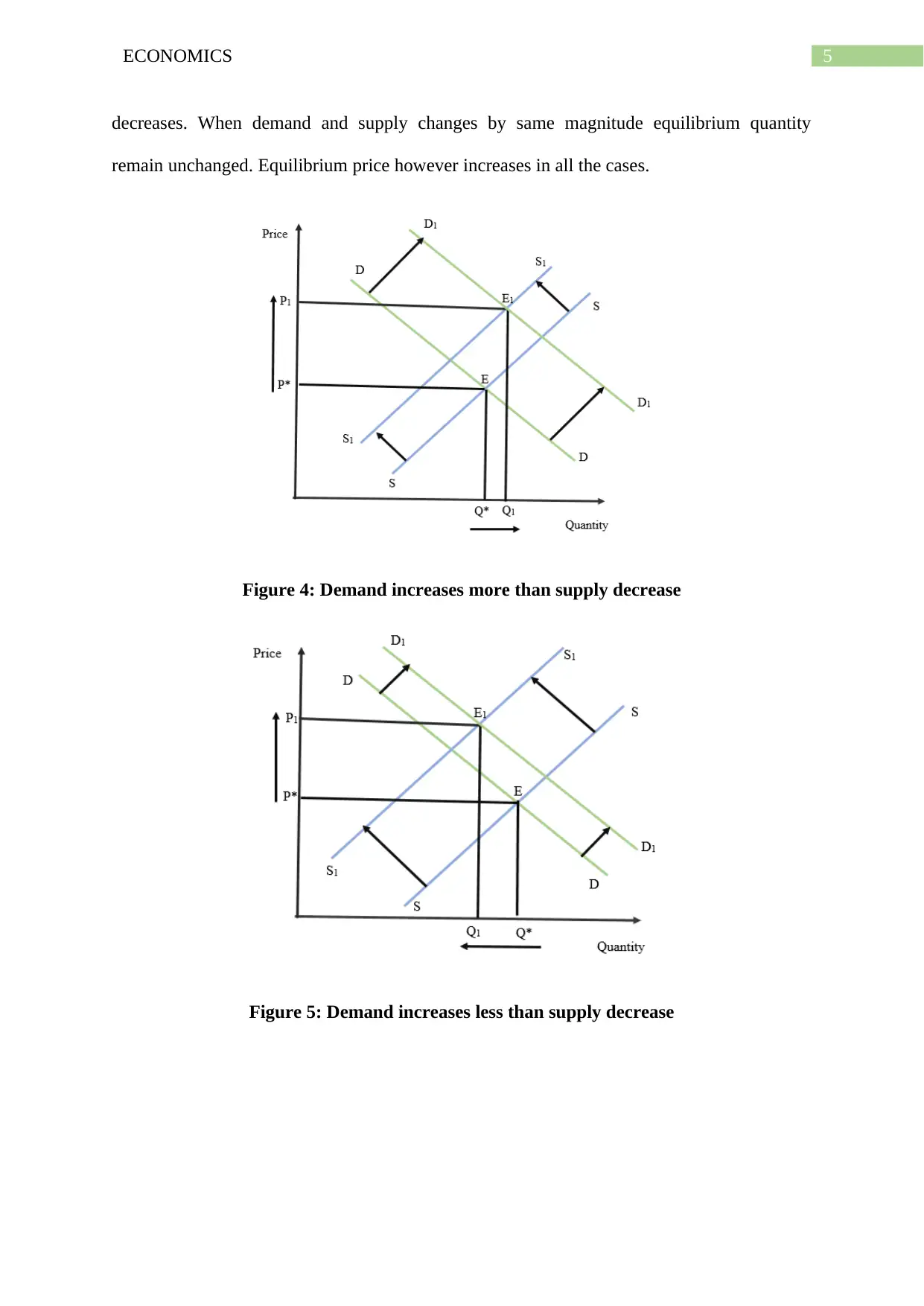
5ECONOMICS
decreases. When demand and supply changes by same magnitude equilibrium quantity
remain unchanged. Equilibrium price however increases in all the cases.
Figure 4: Demand increases more than supply decrease
Figure 5: Demand increases less than supply decrease
decreases. When demand and supply changes by same magnitude equilibrium quantity
remain unchanged. Equilibrium price however increases in all the cases.
Figure 4: Demand increases more than supply decrease
Figure 5: Demand increases less than supply decrease
⊘ This is a preview!⊘
Do you want full access?
Subscribe today to unlock all pages.

Trusted by 1+ million students worldwide
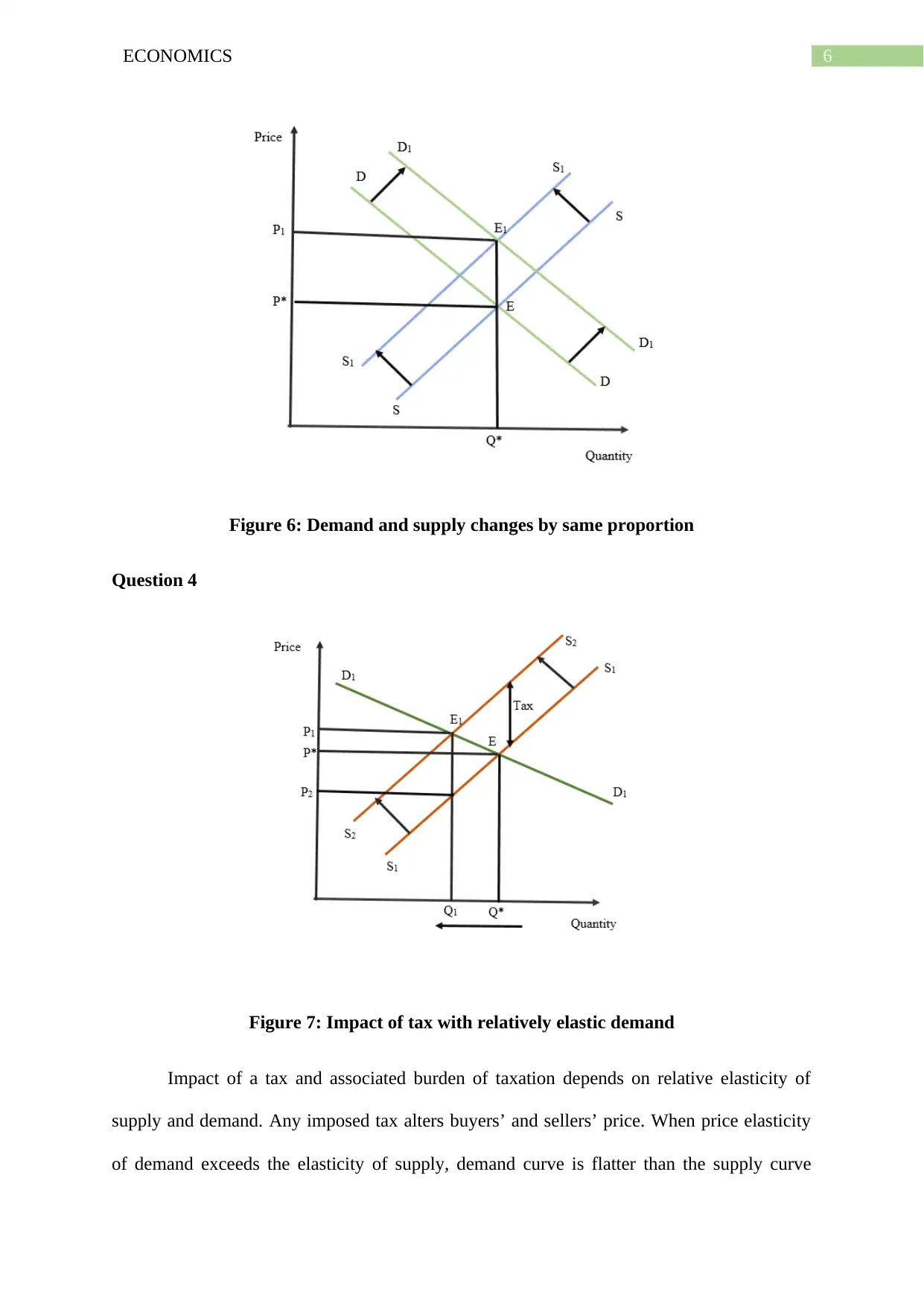
6ECONOMICS
Figure 6: Demand and supply changes by same proportion
Question 4
Figure 7: Impact of tax with relatively elastic demand
Impact of a tax and associated burden of taxation depends on relative elasticity of
supply and demand. Any imposed tax alters buyers’ and sellers’ price. When price elasticity
of demand exceeds the elasticity of supply, demand curve is flatter than the supply curve
Figure 6: Demand and supply changes by same proportion
Question 4
Figure 7: Impact of tax with relatively elastic demand
Impact of a tax and associated burden of taxation depends on relative elasticity of
supply and demand. Any imposed tax alters buyers’ and sellers’ price. When price elasticity
of demand exceeds the elasticity of supply, demand curve is flatter than the supply curve
Paraphrase This Document
Need a fresh take? Get an instant paraphrase of this document with our AI Paraphraser
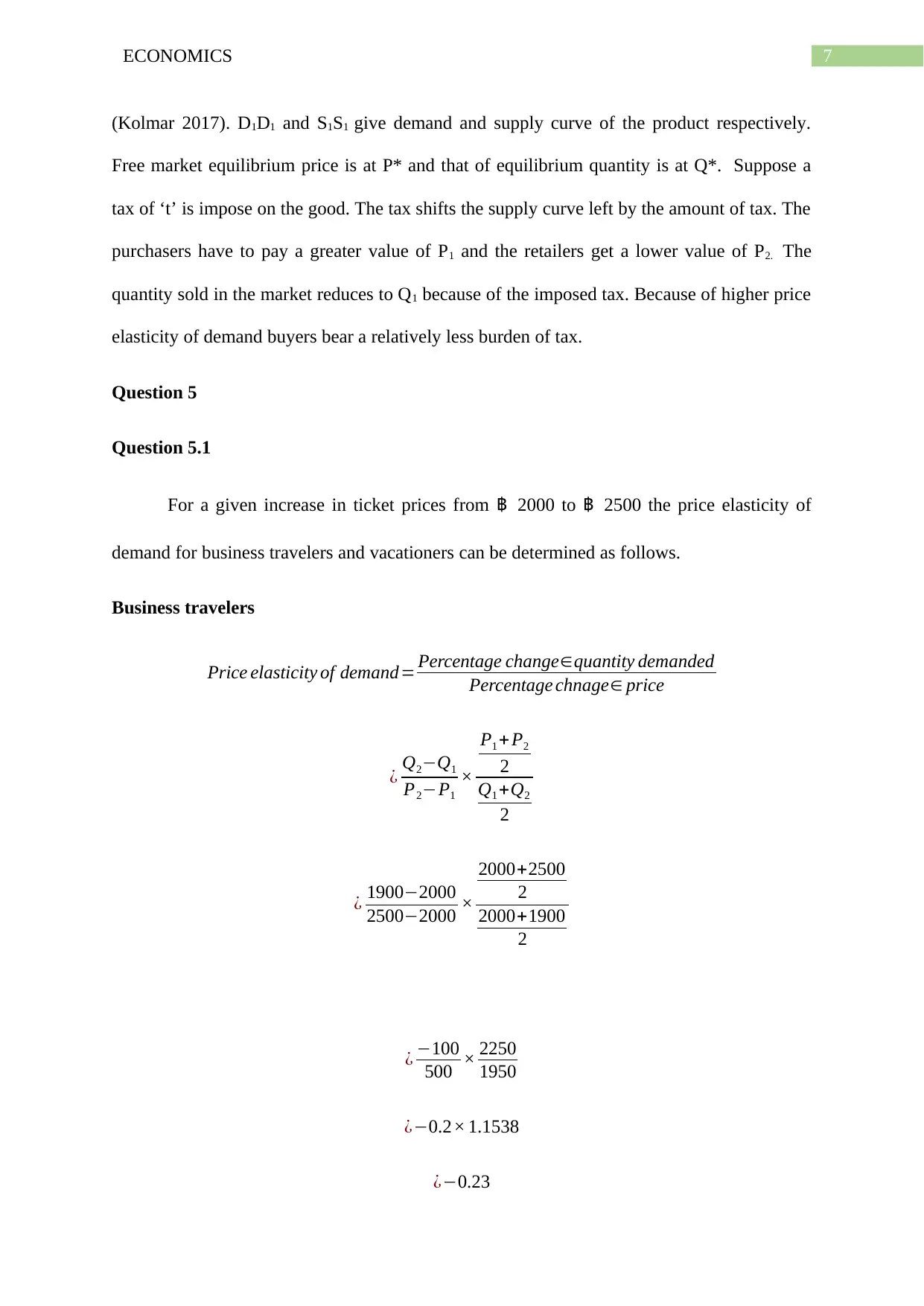
7ECONOMICS
(Kolmar 2017). D1D1 and S1S1 give demand and supply curve of the product respectively.
Free market equilibrium price is at P* and that of equilibrium quantity is at Q*. Suppose a
tax of ‘t’ is impose on the good. The tax shifts the supply curve left by the amount of tax. The
purchasers have to pay a greater value of P1 and the retailers get a lower value of P2. The
quantity sold in the market reduces to Q1 because of the imposed tax. Because of higher price
elasticity of demand buyers bear a relatively less burden of tax.
Question 5
Question 5.1
For a given increase in ticket prices from ฿ 2000 to ฿ 2500 the price elasticity of
demand for business travelers and vacationers can be determined as follows.
Business travelers
Price elasticity of demand= Percentage change∈quantity demanded
Percentage chnage∈ price
¿ Q2−Q1
P2−P1
×
P1 + P2
2
Q1 +Q2
2
¿ 1900−2000
2500−2000 ×
2000+2500
2
2000+1900
2
¿ −100
500 × 2250
1950
¿−0.2× 1.1538
¿−0.23
(Kolmar 2017). D1D1 and S1S1 give demand and supply curve of the product respectively.
Free market equilibrium price is at P* and that of equilibrium quantity is at Q*. Suppose a
tax of ‘t’ is impose on the good. The tax shifts the supply curve left by the amount of tax. The
purchasers have to pay a greater value of P1 and the retailers get a lower value of P2. The
quantity sold in the market reduces to Q1 because of the imposed tax. Because of higher price
elasticity of demand buyers bear a relatively less burden of tax.
Question 5
Question 5.1
For a given increase in ticket prices from ฿ 2000 to ฿ 2500 the price elasticity of
demand for business travelers and vacationers can be determined as follows.
Business travelers
Price elasticity of demand= Percentage change∈quantity demanded
Percentage chnage∈ price
¿ Q2−Q1
P2−P1
×
P1 + P2
2
Q1 +Q2
2
¿ 1900−2000
2500−2000 ×
2000+2500
2
2000+1900
2
¿ −100
500 × 2250
1950
¿−0.2× 1.1538
¿−0.23
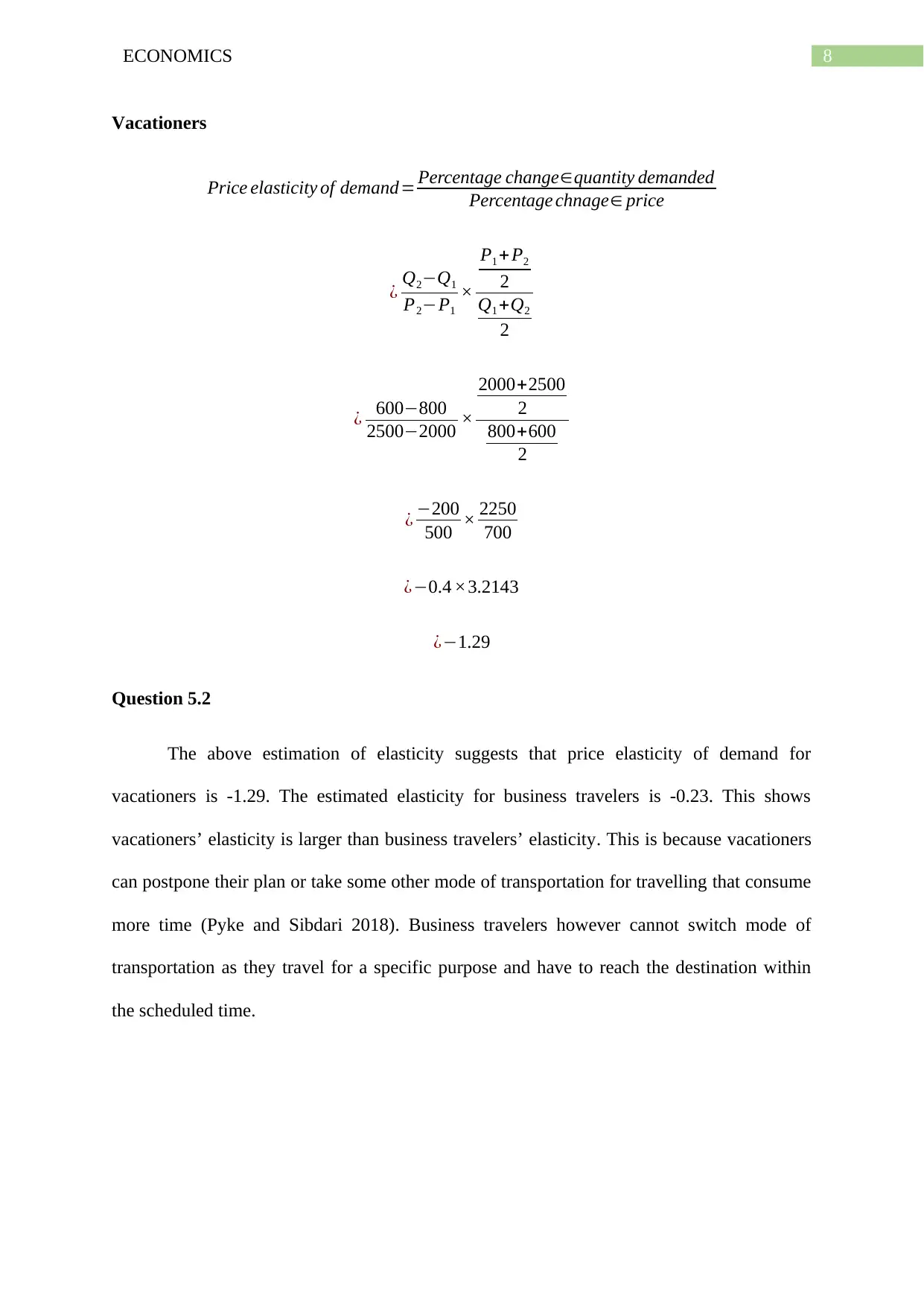
8ECONOMICS
Vacationers
Price elasticity of demand= Percentage change∈quantity demanded
Percentage chnage∈ price
¿ Q2−Q1
P2−P1
×
P1 + P2
2
Q1 +Q2
2
¿ 600−800
2500−2000 ×
2000+2500
2
800+600
2
¿ −200
500 × 2250
700
¿−0.4 ×3.2143
¿−1.29
Question 5.2
The above estimation of elasticity suggests that price elasticity of demand for
vacationers is -1.29. The estimated elasticity for business travelers is -0.23. This shows
vacationers’ elasticity is larger than business travelers’ elasticity. This is because vacationers
can postpone their plan or take some other mode of transportation for travelling that consume
more time (Pyke and Sibdari 2018). Business travelers however cannot switch mode of
transportation as they travel for a specific purpose and have to reach the destination within
the scheduled time.
Vacationers
Price elasticity of demand= Percentage change∈quantity demanded
Percentage chnage∈ price
¿ Q2−Q1
P2−P1
×
P1 + P2
2
Q1 +Q2
2
¿ 600−800
2500−2000 ×
2000+2500
2
800+600
2
¿ −200
500 × 2250
700
¿−0.4 ×3.2143
¿−1.29
Question 5.2
The above estimation of elasticity suggests that price elasticity of demand for
vacationers is -1.29. The estimated elasticity for business travelers is -0.23. This shows
vacationers’ elasticity is larger than business travelers’ elasticity. This is because vacationers
can postpone their plan or take some other mode of transportation for travelling that consume
more time (Pyke and Sibdari 2018). Business travelers however cannot switch mode of
transportation as they travel for a specific purpose and have to reach the destination within
the scheduled time.
⊘ This is a preview!⊘
Do you want full access?
Subscribe today to unlock all pages.

Trusted by 1+ million students worldwide
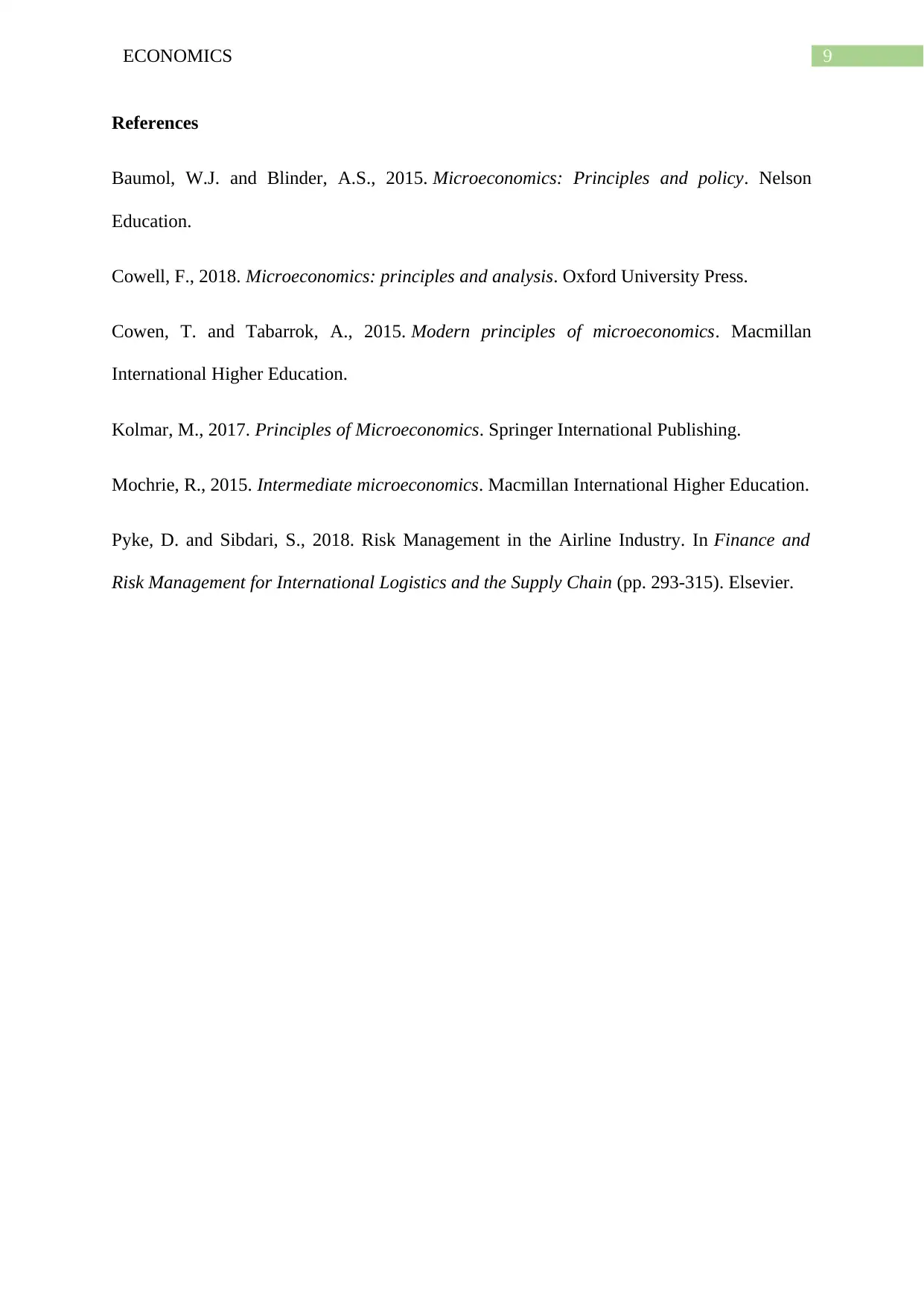
9ECONOMICS
References
Baumol, W.J. and Blinder, A.S., 2015. Microeconomics: Principles and policy. Nelson
Education.
Cowell, F., 2018. Microeconomics: principles and analysis. Oxford University Press.
Cowen, T. and Tabarrok, A., 2015. Modern principles of microeconomics. Macmillan
International Higher Education.
Kolmar, M., 2017. Principles of Microeconomics. Springer International Publishing.
Mochrie, R., 2015. Intermediate microeconomics. Macmillan International Higher Education.
Pyke, D. and Sibdari, S., 2018. Risk Management in the Airline Industry. In Finance and
Risk Management for International Logistics and the Supply Chain (pp. 293-315). Elsevier.
References
Baumol, W.J. and Blinder, A.S., 2015. Microeconomics: Principles and policy. Nelson
Education.
Cowell, F., 2018. Microeconomics: principles and analysis. Oxford University Press.
Cowen, T. and Tabarrok, A., 2015. Modern principles of microeconomics. Macmillan
International Higher Education.
Kolmar, M., 2017. Principles of Microeconomics. Springer International Publishing.
Mochrie, R., 2015. Intermediate microeconomics. Macmillan International Higher Education.
Pyke, D. and Sibdari, S., 2018. Risk Management in the Airline Industry. In Finance and
Risk Management for International Logistics and the Supply Chain (pp. 293-315). Elsevier.
1 out of 10
Related Documents
Your All-in-One AI-Powered Toolkit for Academic Success.
+13062052269
info@desklib.com
Available 24*7 on WhatsApp / Email
![[object Object]](/_next/static/media/star-bottom.7253800d.svg)
Unlock your academic potential
Copyright © 2020–2025 A2Z Services. All Rights Reserved. Developed and managed by ZUCOL.





